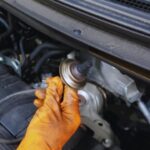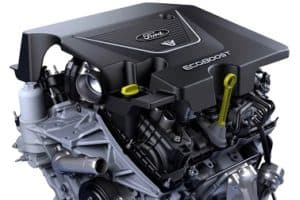The crankshaft position sensor plays an important role in a vehicle. It measures the rotation speed or the revolutions per minute and informs you whether the engine crankshaft is precise. So, what will happen to a vehicle with a bad crankshaft position sensor?
If there are any issues with the crankshaft position sensor or even its wiring, the crankshaft signal will tend to be cut off while the engine is running. If this happens, the engine can stall. This is a common symptom involving wiring. There are several other symptoms of a bad crankshaft position sensor.
Crankshaft position sensor symptoms include the following:
- Difficulty starting the vehicle
- Intermittent stalling
- Check Engine Light turns on
- Inconsistent acceleration
- Engine misfires
- Vibrating engine or rough idle
- Decreases overall fuel economy
Read on to learn more about the symptoms of a bad crankshaft position sensor and how to fix it.
Crankshaft Position Sensor Symptoms

If there are any problems with the crankshaft position sensor or its wiring, the crankshaft signal will be cut off while the engine is running. In which case, the engine can get stalled. This is a typical symptom involving the wiring. There are several other symptoms of a bad crankshaft position sensor.
Crankshaft position sensor symptoms include the following:
- Difficulty starting the vehicle
- Intermittent stalling
- Check Engine Light turns on
- Inconsistent acceleration
- Engine vibrates or misfires
- Vibrating engine or rough idle
- Decreases overall fuel economy
Let’s discuss each one of them:
1. Difficulty Starting the Vehicle
One of the most common symptoms, if not the most common, of a failing or bad crankshaft position sensor, is the problem with starting the vehicle. It is not only the speed and position of the crankshaft that the crankshaft position sensor monitors. This sensor also monitors other parameters related to starting the engine.
If there is an issue with the sensor, either the starting issues are intermittent, or the vehicle won’t start at all.
2. Intermittent Stalling
Issues of intermittent stalling are also a symptom associated with a bad crankshaft position sensor. A problem with the sensor or even its wiring can result in a cut-off crankshaft signal while the engine is running. This then causes the engine to stall.
In most cases, when this symptom arises, the problem is the wiring. But there is a likelihood that the problem is also with the sensor itself.
3. “Check Engine Light” Turns On
An illuminated Check Engine Light is an indication that there is a problem with the crankshaft position sensor. This alerts the driver of the issue.
4. Inconsistent Acceleration
The problem arises if the input that comes from the crankshaft position sensor is inaccurate. In which case, adjustments to fuel injection and spark timing as the engine speed increases can’t be made by the engine control unit.
Lack of accuracy causes inconsistent acceleration. Thus, making it hard to maintain speed consistently.
5. Engine Misfires
A brief stutter in the engine could indicate misfiring cylinders resulting from a bad crankshaft position sensor.
If the sensor is broken, it can’t connect piston positioning information. This then causes the cylinder to misfire.
A similar incident can occur from faulty spark plug timing. However, if the spark plug checks out, the source is most likely the crankshaft sensor.
6. Vibrating Engine or Rough Idle
Rough idling is another indication that there is an issue with the crankshaft position sensor. You will notice this when the vehicle is idle. The engine either vibrates or grinds. This is an indication that the sensor fails to monitor the position of the crankshaft. This then leads to vibrations that impact overall engine power.
The ability of the engine to track mileage might also be affected due to the vibration. Typically, if you notice the vehicle vibrating abnormally, it should be checked immediately.
7. Decreases Overall Fuel Economy
Inaccurate timing information coming from the crankshaft position sensor affects fuel economy. This is because the fuel injectors will not be able to pump gas into the engine efficiently. This will result in the engine using more gas than usual, whether during long or short drives. Thus, decreasing overall fuel economy.
The crankshaft position sensor has a great impact on smooth engine functionality and performance. The sensor provides a vital signal for engine calculations. Problems with the sensor quickly lead to issues that impact the drivability of the vehicle.
So, to reiterate, if there are any issues with the crankshaft position sensor or even its wiring, the crankshaft signal will tend to be cut off while the engine is running. In which case, the engine can get stalled. This is a common symptom involving wiring.
Again, here are several other symptoms of a bad crankshaft position sensor, including:
- Difficulty starting the vehicle
- Intermittent stalling
- Check Engine Light turns on
- Inconsistent acceleration
- Engine vibrates or misfires
- Vibrating engine or rough idle
- Decreases overall fuel economy
Where Is the Crankshaft Position Sensor Located?

The crankshaft position sensor location varies, depending on the type of vehicle. But no matter where it is located, it has always to be close to the crankshaft.
In most cases, it is positioned on the front underside of the engine. Typically, it is found mounted to the timing cover. Other times, it is found mounted at the rear or the edge of the engine.
There are instances when the crankshaft position sensor also measures the speed of the clutch flywheel. This is to be able to determine the crankshaft’s speed. In which case, the sensor may be found mounted to the transmission’s bell housing.
Crankshaft Position Sensor Replacement
If you consider doing a temporary fix for the crankshaft position sensor, this might not be a good idea. If you have adequate knowledge when it comes to fixing cars, then there is a likelihood that you can replace and fix it on your own.
Here are the steps:
- Disconnection of the battery
- Clearing of access to the crankshaft position sensor
- Identifying the exact crankshaft position sensor location
- Releasing of the electrical connector
- Removal of the sensor mount bolt
- Sensor removal
- Ensuring that the new and old sensors are identical
- Installation of the new crankshaft position sensor
- Reconnection of the battery
1. Disconnection of the Battery
Every time you work on the engine’s inner part, it is always good to disconnect the battery. That way, you can prevent a short circuit to the electrical system of the vehicle.
When it comes to hybrid vehicles, make sure that the main battery pack’s disarm plug is detached.
2. Clearing of Access to the Crankshaft Position Sensor
There are crankshaft position sensors that are located behind the starter motor. In which case, you have to remove the starter motor to access the sensor. You might need a reliable shop light to see what you are working on clearly.
3. Identifying the Exact Crankshaft Position Sensor Location
While we know that the crankshaft position sensor is located near the crankshaft, it is challenging to locate it. This is due to the transmission cooling lines. But it is most likely located on the side of the block with the attached electrical connector.
If the crankshaft angle sensor is oily, it is best to apply a small carburetor cleaner. That way, you will be able to remove the oil and conveniently start on the job.
4. Releasing of the Electrical Connector
Using a plastic clip, you may attach the electrical connector to the sensor. You may press the clip down or pull it up to release. Once done, loosen the connector from the sensor by gently wiggling it.
At times, you might find the connector stuck caused by the weather pack seal. This seal prevents water from causing corrosion at the sensor terminals. So, when you remove the connector, be sure to clean it to remove rust. If the pigtail is worn out, you might have to replace it too. While this is a different issue from the sensor, it can nonetheless cause the engine to stall.
5. Removal of the Sensor Mount Bolt
Typically, a crankshaft position sensor features only one mount bolt with a 10 mm bolt. To remove it, use a small socket or wrench and turn it counterclockwise. Then, make sure to keep it safe.
6. Sensor Removal
You might find sensor removal a little bit difficult to do. This is because the sensor has a long stem and tends to get stuck in the block.
- Wedge under the sensor mounting tab using a standard screwdriver or a small pick to get the job done. This is expected to pry it loose.
- Do not apply much pressure when removing the sensor. Otherwise, you might accidentally leave a part of the sensor within the block.
- Once you have loosened the sensor, grasp it firmly, then twist it to pull it successfully from the engine block. You will notice a sealing ring on the sensor, which you will have to replace with the new sensor. When you buy a new sensor, the ring comes along with it.
7. Ensuring That the New and Old Sensors Are Identical
Once you have removed the old sensor, wipe any dirt or oil off it to scrutinize it. Check the design and confirm if it matches the new sensor. Make sure the length is the same. If the new one is longer, it will touch the crankshaft. Whereas if it is shorter, the sensor will fail to read correctly.
8. Installation of the New Crankshaft Position Sensor

Before you install the new crankshaft position sensor, clean the sensor port hole first. That way, you can ensure that the new sensor ring will properly seal. You may use a shop towel to clean it.
You will surely notice motor oil in the port, so avoid spraying carburetor cleaner inside it. Instead, spray the cleaner on the shop towel.
- Firmly place the new crankshaft position sensor into the porthole. At the same time, align the mounting plate hole to the threaded bolt hole in the block. Insert then the mounting bolt and thread it using your hand. Do a clockwise turn of the bolt and avoid cross-threading.
- You may lubricate the ring seal by applying a small amount of engine oil or WD-40. That way, you will avoid damaging the seal that might cause an oil leak.
- After installing the sensor, thread the mounting bolt and tighten it to approximately 3-foot lbs.
- When pushing the electrical connector into place, wait for a clicking sound. You indicate that the installation of the crankshaft position sensor is done successfully.
9. Reconnection of the Battery
You may now carefully remove the jack off the vehicle. Then, reconnect the battery cable so you can finally use the vehicle.
Conclusion – Crankshaft Position Sensor
To reiterate, if there are any problems with the crankshaft position sensor or its wiring, the crankshaft signal tends to be cut off while the engine is running. In which case, the engine can get stalled. This is a typical symptom involving the wiring.
There are several other symptoms of a bad crankshaft position sensor which include the following:
- Difficulty starting the vehicle
- Intermittent stalling
- Check Engine Light turns on
- Inconsistent acceleration
- Engine misfires
- Vibrating engine or rough idle
- Decreases overall fuel economy
If you are not a professional car mechanic but have adequate knowledge about fixing vehicles, you can most likely fix the problem with your vehicle’s crankshaft position sensor. So, in case you are considering doing a temporary fix for the crankshaft position sensor, I suggest you abandon this thought. A temporary fix might only leave permanent damage to your vehicle.
My suggestion is to follow the steps we have discussed. For sure, you will be able to replace your vehicle’s crankshaft position sensor in a matter of minutes.
Related reading:
Can You Drive with a Bad Mass Air Flow Sensor?



![Transmission Control Module Location [for Various Models] transmission control module location](https://roadsumo.com/wp-content/uploads/2022/12/transmission-control-module-location-150x150.jpg)
![How to Fix a Bad O2 Sensor [Oxygen Sensor Repair] How to Fix a Bad O2 Sensor](https://roadsumo.com/wp-content/uploads/2021/10/how-to-fix-a-bad-O2-sensor-150x150.jpg)
![Rod Bearing [What is It, How to Replace It, and Replacement Cost] rod bearing](https://roadsumo.com/wp-content/uploads/2021/05/rod-bearing-150x150.jpeg)



